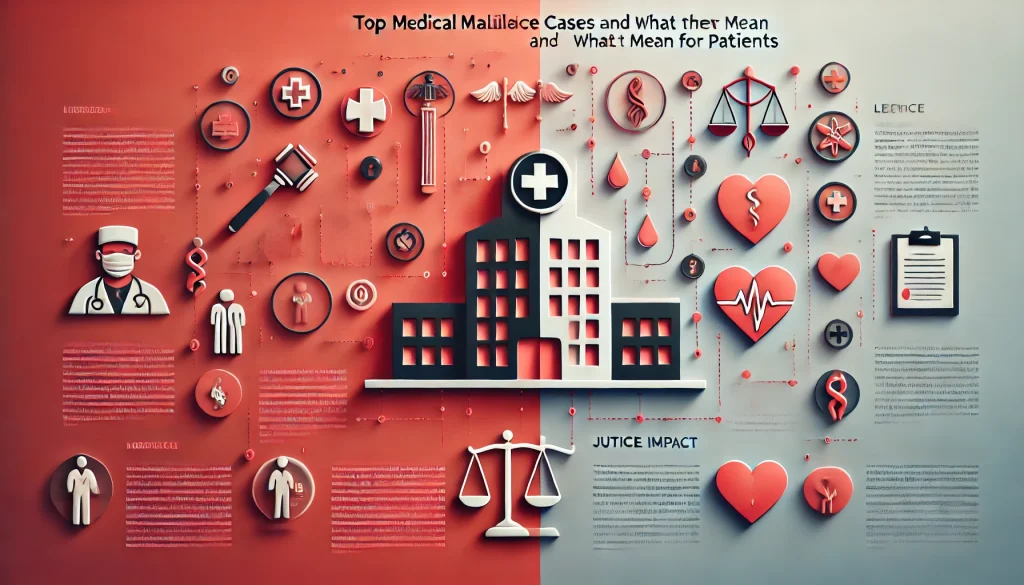Top US Medical Malpractice Cases: Key Lessons for Every Patient

Introduction
US Medical Malpractice Cases is a serious issue that affects thousands of patients every year across the United States. From surgical errors to misdiagnoses, the consequences can be life-changing for those involved. For patients, understanding key medical malpractice cases and their outcomes can provide critical insights into the importance of their rights and the legal recourse available when negligence occurs.
This article will explore the top medical malpractice cases in the U.S., the lessons they provide, and how patients can protect themselves. If you or someone you know has been affected by medical malpractice, knowing your legal options can be the first step toward seeking justice.
Table of Contents
What Is Medical Malpractice?
US Medical Malpractice Cases occurs when a healthcare provider, such as a doctor, nurse, or hospital, fails to provide the standard of care expected in the medical community, resulting in harm to the patient. This negligence may arise from errors in diagnosis, treatment, aftercare, or health management.
To succeed in a medical malpractice case, a patient (plaintiff) must typically prove the following:
- A doctor-patient relationship existed.
- The healthcare provider was negligent.
- The negligence caused injury.
- The injury led to specific damages such as physical pain, mental anguish, additional medical bills, or lost income.
By examining real-life cases, patients can better understand the scope and consequences of medical malpractice.
Top US Medical Malpractice Cases and What We Can Learn
1. The Case of Dorrence Kennedy vs. Missouri Baptist Medical Center
Overview:
In 2000, Dorrence Kennedy underwent routine knee surgery. Following the operation, he developed a blood clot that ultimately led to his death. His wife claimed the hospital failed to provide sufficient care post-surgery, including proper monitoring and timely diagnosis of the clot. The lawsuit led to a $2.58 million settlement.
Lesson:
Post-operative care is just as important as the surgery itself. Hospitals and healthcare providers must continuously monitor patients for complications to prevent fatal consequences. Patients should be proactive about their care, asking questions and ensuring they receive adequate follow-up care.
2. The Tragic Case of Libby Zion
Overview:
Libby Zion was an 18-year-old who was admitted to New York Hospital in 1984 with flu-like symptoms. Over the course of her treatment, she was given a combination of medications that interacted negatively, leading to her death. Her father pursued a malpractice lawsuit, which revealed dangerous flaws in resident work hours and supervision. The hospital eventually settled for $375,000, and the case led to reforms that restricted the number of hours medical residents could work consecutively.
Lesson:
This case highlights the importance of hospital staffing and supervision, especially for inexperienced medical professionals. It underscores the need for transparency and communication about medication and treatments, encouraging patients to inquire about possible drug interactions.
3. The Case of Jesica Santillan
Overview:
Jesica Santillan, a 17-year-old, received a heart and lung transplant at Duke University Hospital in 2003. Tragically, the organs were not compatible with her blood type, leading to her death shortly after the surgery. The error resulted in significant media coverage and a malpractice settlement with the family.
Lesson:
The importance of double-checking critical medical details, like organ compatibility, cannot be overstated. Medical institutions must have fail-safes to prevent such errors. Patients and families should always feel empowered to ask for verification during the treatment process.
4. The Dennis Quaid Twins’ Overdose
Overview:
In 2007, actor Dennis Quaid’s newborn twins were mistakenly given an overdose of the blood thinner Heparin while being treated at Cedars-Sinai Medical Center in Los Angeles. Fortunately, the twins survived after the overdose was discovered in time, but the case resulted in a lawsuit and a settlement.
Lesson:
US Medical Malpractice Cases errors are one of the most common forms of medical malpractice. Hospitals need strict protocols to avoid dangerous dosages, especially in vulnerable patients like infants. Patients and families can play a role in confirming medications and dosages to prevent these life-threatening mistakes.
5. The Johns Hopkins Gynecologist Scandal
Overview:
In 2013, Johns Hopkins Hospital settled a case for $190 million, the largest medical malpractice settlement in U.S. history. The case involved Dr. Nikita Levy, a gynecologist who secretly recorded patients during exams using a camera hidden in a pen. Thousands of women were affected by this breach of trust and privacy.
Lesson:
This US Medical Malpractice Cases demonstrates the importance of trust between healthcare providers and patients. It also underscores the necessity of patient vigilance in reporting suspicious behavior. Always feel empowered to speak up if something seems wrong during a medical appointment.
What Do These Cases Teach Us About Protecting Patient Rights?
Each of these landmark cases provides important lessons for patients about their rights in the healthcare system. Whether it’s preventing surgical errors, avoiding medication mistakes, or ensuring proper post-operative care, these cases show the importance of being an informed and proactive patient.
Here are key takeaways to protect yourself as a patient:
- Ask Questions: Always ask about treatments, medications, and procedures. Make sure you fully understand your diagnosis and any associated risks.
- Request Second Opinions: For serious medical conditions, seek a second opinion to confirm your diagnosis and treatment options.
- Stay Informed About Your Medications: Understand the purpose, side effects, and potential interactions of any medications you are prescribed.
- Demand Proper Care: If you feel your healthcare provider is not giving you the attention you need, speak up or request a different provider.
- Document Everything: Keep a record of your medical visits, treatments, and medications. This documentation can be crucial if you ever need to pursue a malpractice claim.
How to File a Medical Malpractice Lawsuit
Filing a US Medical Malpractice Cases can be a complex process. If you believe you’ve been a victim of malpractice, here are the basic steps to follow:
Step 1: Hire an Experienced Medical Malpractice Lawyer
US Medical Malpractice Cases vary by state, and cases often require expert testimony and detailed medical evidence. Hiring a lawyer who specializes in malpractice cases is essential to navigate this process.
Step 2: Obtain Your Medical Records
Your medical records will serve as the foundation of your case. Your lawyer will use these records to identify any lapses in care, such as missed diagnoses or improper treatments.
Step 3: Review by a Medical Expert
Most states require a medical expert to review the case and certify that the healthcare provider’s negligence directly caused your injury. Your attorney will coordinate this review.
Step 4: File the Complaint
Your attorney will file the lawsuit, outlining the claims of negligence against the healthcare provider or institution.
Step 5: Discovery Process
Both sides will exchange evidence during the discovery process, which may include depositions, interrogatories, and document requests.
Step 6: Settlement or Trial
Most malpractice cases are settled before reaching trial. However, if a settlement cannot be reached, your case will go before a jury, where your lawyer will present evidence to prove negligence and seek compensation on your behalf.
What Compensation Can Patients Expect in Medical Malpractice Cases?
Compensation for medical malpractice typically includes:
- Medical Expenses: This covers the cost of additional treatments or surgeries needed due to the malpractice.
- Lost Wages: If you were unable to work due to your injury, you might be compensated for lost wages or reduced earning capacity.
- Pain and Suffering: Non-economic damages like emotional distress, physical pain, and loss of enjoyment of life are often included.
- Future Medical Care: For long-term injuries, compensation may cover the cost of future medical treatments or rehabilitation.
- Punitive Damages: In cases of extreme negligence, punitive damages may be awarded to punish the healthcare provider and deter future misconduct.
The Importance of Choosing the Right Lawyer
Choosing the right attorney is crucial when pursuing a medical malpractice claim. Look for an attorney with a proven track record of handling malpractice cases and who can provide references or testimonials from past clients.
At [Your Law Firm Name], our team of experienced medical malpractice attorneys understands the complexities of these cases and fights to ensure that patients receive the compensation they deserve. Contact us today for a free consultation.
Contact Us
If you or a loved one has been a victim of medical malpractice, don’t wait to take action. Contact us to schedule a free consultation and discuss your legal options.
Location:
1234 Medical Justice Avenue, Suite 500
City, State, ZIP Code
Phone: (555) 123-4567
Website: www.topmedicalmalpracticefirm.com
Conclusion
Medical malpractice can have devastating effects on patients and their families. The top U.S. cases highlighted in this article demonstrate how negligent care can result in life-altering consequences, but they also offer hope and lessons for future patients. By staying informed, advocating for yourself, and understanding your rights, you can better protect yourself from medical errors.
If you believe you’ve been harmed by medical negligence, contact an experienced malpractice attorney today to explore your legal options and ensure that justice is served.


